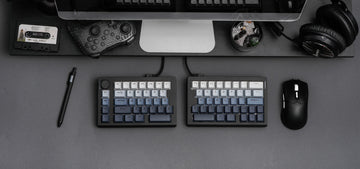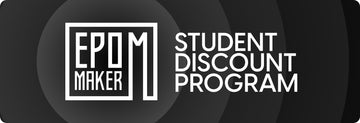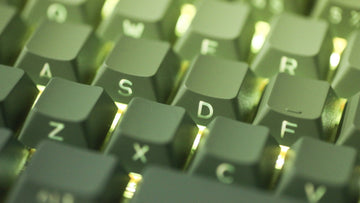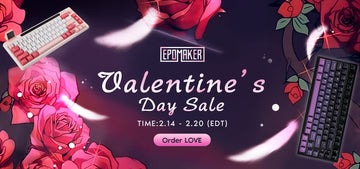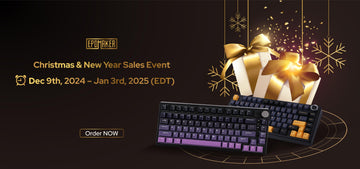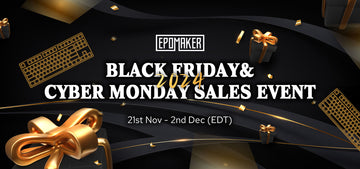1. Keycap Materials
Keycap materials is essential for improving your typing experience. Different materials like PBT and ABS offer varying levels of durability, texture, and aesthetic appeal. Choosing the right material ensures long-term durability, comfortable typing, and personalized aesthetics for your keyboard setup.
ABS (Acrylonitrile Butadiene Styrene):

ABS is a versatile material commonly used for keycaps due to its affordability and ease of production. It provides a smooth surface finish and is available in a wide range of colors. If you're a fan of vibrant colors and smooth finishes, ABS keycaps offer a wide range of options. ABS keycaps are generally more affordable compared to keycaps made from other materials, making them an excellent choice for budget-conscious consumers. However, one of the main drawbacks of ABS keycaps is that they are prone to developing a shiny or greasy appearance over time with extended use, especially on frequently used keys like the spacebar and WASD keys. ABS has a lower melting point compared to other materials like PBT, making ABS keycaps more susceptible to warping or melting when exposed to high temperatures, such as from prolonged exposure to direct sunlight or hot drinks. Overall, ABS keycaps offer a balance of affordability, customization options, and aesthetics, making them a popular choice for many mechanical keyboard enthusiasts.
PBT (Polybutylene Terephthalate):
PBT is a popular material used in manufacturing keycaps for mechanical keyboards, known for its durability and high-quality feel. PBT keycaps have a slightly textured surface that provides a comfortable typing experience and prevents keycap shine over time, maintaining their appearance for longer periods. PBT has a higher melting point compared to ABS, making PBT keycaps more resistant to heat and less prone to warping or melting, even with prolonged exposure to sunlight or high temperatures. Due to their high durability and resistance to shine, PBT keycaps generally have a longer lifespan compared to other materials like ABS, providing users with a more long-lasting keyboard customization option. Users looking for keycaps with a premium look and feel, as well as resistance to discoloration and shine, may appreciate the aesthetic appeal of PBT keycaps. PBT keycaps are typically more expensive to manufacture compared to ABS keycaps, resulting in a higher cost for consumers. However, many users consider the higher price justified by the increased durability and longevity of PBT keycaps.
POM (Polyoxymethylene):

POM keycaps are valued for their high hardness and self-lubricating properties. They offer a smooth, cool feel and excellent durability. Although less common than ABS and PBT, POM keycaps provide a unique typing experience that is appreciated by some enthusiasts. POM keycaps have low friction properties, resulting in a smooth and quiet typing experience that may appeal to users who prefer a quieter keyboard. While POM keycaps are available in a variety of colours, the manufacturing process and limited availability from keyboard manufacturers may limit the colour options compared to other materials. As a result, enthusiasts who value durability, precision and a smooth typing experience over a colourful appearance may prefer POM keycaps for their unique properties and premium feel.
PC (Polycarbonate):
PC material has excellent abrasion resistance and durability, as well as excellent transparency and smoothness, giving the keycaps a clear and bright appearance, allowing the creation of transparent or translucent keycaps that can be backlit for aesthetic appeal or improved visibility in low light conditions. Compared to other materials, PC keycaps are lighter and softer to the touch, providing a more comfortable typing experience. In addition, PC keycaps are prone to yellowing over time when exposed to UV light, resulting in a loss of aesthetic appeal. However, this problem can be mitigated by using UV-resistant coatings or materials. Users who value aesthetics and enjoy the visual appeal of transparent or translucent keycaps with vivid backlighting will appreciate the unique look of PC keycaps, and gamers who play in low-light environments and rely on backlighting for improved visibility will benefit from PC keycaps that enhance the overall user experience.
2. Keycap Printing Techniques
Keycaps come in various printing techniques, each offering unique characteristics and benefits. As a beginner, understanding these techniques can help you choose keycaps that not only look great but also meet your preferences and needs.
Screen Printing:

Screen printing is a traditional method used to apply legends (characters or symbols) onto keycaps. It involves using a mesh screen to transfer ink onto the keycap surface, creating sharp and vibrant legends. Screen printing allows for precise detailing and can produce complex designs with multiple colors. However, it may wear off over time with extensive use.
Laser Etching:

Laser etching utilizes a high-powered laser to burn legends directly into the surface of the keycaps. This method produces durable and permanent markings that are resistant to fading and wear. Laser etching creates high-contrast legends with crisp edges, making them easy to read. While it offers excellent longevity, laser etching is limited to single-color designs and may not be suitable for intricate patterns or graphics.
Dye-Sublimation (Heat Sublimation):
Dye-sublimation printing involves transferring ink into the surface of the keycaps using heat and pressure. This process sublimates the ink, causing it to penetrate the keycap material and become part of its surface. Dye-sublimated legends are highly durable and resistant to fading, as the ink becomes an integral part of the keycap. This technique allows for vibrant, full-color designs with intricate detailing. Dye-sublimation is preferred for complex graphics and multicolor designs, offering superior longevity and color retention compared to other printing methods.
Double-shot Molding:
Double-shot molding is a manufacturing process where two layers of plastic are molded together to create a keycap with two distinct colors or layers. The legends are formed by injecting a different-colored plastic into the mold, resulting in a durable, two-tone keycap with legends that will never fade or wear off. Double-shot keycaps offer unmatched durability and customization options, as the colors are integrated into the keycap material itself. They provide a premium look and feel, making them a popular choice among enthusiasts.
3. Keycap Sizing and Compatibility
Keyboard compatibility is a critical consideration for enthusiasts seeking to customize their mechanical keyboards with new keycap sets. Imagine the excitement of receiving a new set of keycaps, only to discover that the spacebar or Enter key doesn't fit properly. It can be a frustrating experience, leaving you puzzled and uncertain about what went wrong. In this part, we'll explore the concept of keyboard compatibility and delve into the intricacies of keycap sizing and layout compatibility.
Keycap sizing refers to the dimensions of individual keycaps, measured in terms of width and profile. To understand compatibility, it's essential to grasp the concept of keycap sizing relative to the keyboard layout. Keycap sets are typically designed based on a standardized layout, with keycaps labeled according to their size relative to a base unit, often referred to as 1X.
For example, the width of the Win key on a standard keyboard layout may be designated as 1X. Consequently, the width of other keys, such as ALT or SHIFT, is measured relative to the Win key. If the Win key is 1X wide, the ALT key may be 1.5X wide, and the SHIFT key may be 2X wide. This proportional sizing ensures uniformity and compatibility across different keycap sets. However, variations in keyboard layouts among different manufacturers can lead to inconsistencies in keycap sizing. Certain keyboards may deviate from the standard layout, resulting in non-standard keycap sizes. As a result, keycap sets designed for one keyboard layout may not be compatible with keyboards featuring a different layout.
Navigating keyboard layouts and compatibility can be daunting, especially for newcomers to the mechanical keyboard hobby. Fortunately, online retailers like Epomaker offer a diverse range of keyboards tailored to different layouts and preferences.
Epomaker's product lineup includes keyboards featuring various layouts, such as 60%, 96% and TKL (Tenkeyless) keyboards. Each layout caters to different usage scenarios and preferences, allowing users to choose the one that best suits their needs.
For example, the SKYLOONG GK68X/GK68XS is a versatile 65% keyboard featuring a compact layout with dedicated arrow keys, Featuring dye-subbed PBT keycaps in GSA profile for durability and ergonomic design, it's ideal for gamers and typists alike. Customize with 16.8 million RGB lighting effects and three programmable Fn macros, it's the ultimate choice for versatility and performance in any setting. In conclusion, keycaps are more than just buttons on a keyboard—they're an opportunity for personal expression and customization.
Upgrade your keyboard with the Epomaker new arrival 80 Retros GAME 1989 Keycap Set and add a splash of retro flair to your daily computing experience. Whether you're reliving the glory days of arcade gaming or simply adding a touch of nostalgia to your workspace, these keycaps are sure to turn heads and spark conversations. Made from high-quality PBT material, these keycaps are durable and resistant, crafted with meticulous attention to detail, make your keyboard stand out from the normal.
Whether you're looking for durability, aesthetics, or a unique typing experience, there's a keycap material and style to suit your preferences. So, dive in, explore different options, and let your keyboard reflect your personality and style!



